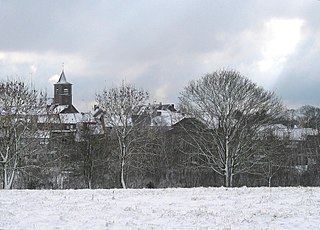
Beaumont is a city and municipality of Wallonia located in the Belgian province of Hainaut, on the border with France.

Erquelinnes is a municipality of Wallonia located in the province of Hainaut, Belgium.
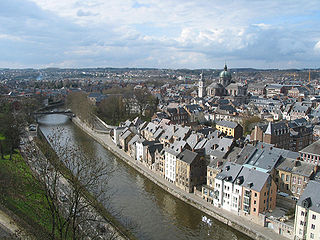
The Sambre is a river in northern France and in Wallonia, Belgium. It is a left-bank tributary of the Meuse, which it joins in the Wallonian capital Namur.
Philippe Emanuel, Prince of Hornes, Prince of Overisque, Count of Solre-le-Château, was the son of Eugene Maximilian, Prince of Hornes and Princess Anne Marie Jeanne of Croÿ. He married Princess Marie Anne Antoninette of Ligne.

The House of Hornes was an old and important European noble family, which became extinct in the male line in 1826. The name refers to Horn, a small village in Limburg, located in the Netherlands.
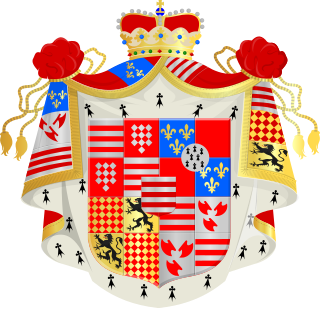
The House of Croÿ is a family of European mediatized nobility, which held a seat in the Imperial Diet from 1486, and was elevated to the rank of Princes of the Holy Roman Empire in 1594. In 1533 they became Dukes of Arschot and in 1598 Dukes of Croy in France. In 1913, the family had branches in Belgium, France, Austria and Prussia.

The Château de Serrant is a Renaissance château situated in the Loire Valley, 15 kilometres (9.3 mi) to the west of Angers. The château is the private residence of the Prince of Merode, but it is open to visitors.
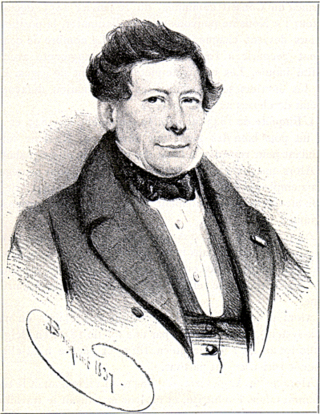
Philippe Félix Balthasar Otto Ghislain, Count de Merode, known as Félix de Merode, was a Belgian politician. He has been called "the architect of Belgian independence'.

The House of Merode is one of the most prominent families of the Belgian nobility. It originates from the village of Merode, which is now in the municipality of Langerwehe in Germany. Over the past five centuries, different branches bore noble titles and had estates on the territories of the modern-day states of Germany, Belgium, the Netherlands, France and Austria. Through marriage, the house is connected with many prominent European noble families. The House of Merode played an important role in the history of the Southern Netherlands and the Kingdom of Belgium.
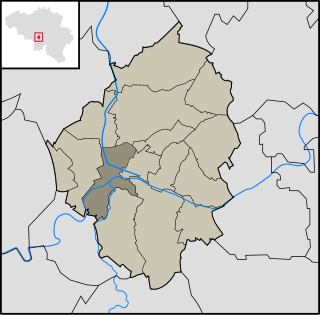
Marchienne-au-Pont is a town of Wallonia and a district of the municipality of Charleroi, located in the province of Hainaut, Belgium.
Cartier Castle is a château in Marchienne-au-Pont, a district of Charleroi, in the province of Hainaut, Wallonia, Belgium.

Ham-sur-Heure Castle is a castle in Ham-sur-Heure, a village in the municipality of Ham-sur-Heure-Nalinnes, province of Hainaut, Wallonia, Belgium.

Jan (Jean) I Carondelet was a Burgundian jurist and politician. He was the son of Jean Carondelet and Jeanne de Basan.

Jean Charles Joseph, Count of Merode, Marquess of Deynze was a noble of the Austrian Netherlands, born in the Prince-Bishopric of Liège. He was Lieutenant-Feldmarschall of the Holy Roman Empire, Knight of the Order of the Golden Fleece.

The Battle of Erquelinnes or Battle of Péchant was part of the Flanders Campaign during the War of the First Coalition, and saw a Republican French army jointly led by Jacques Desjardin and Louis Charbonnier try to defend a bridgehead on the north bank of the Sambre River against a combined Habsburg Austrian and Dutch army led by Franz Wenzel, Graf von Kaunitz-Rietberg. The French crossed the Sambre on the 20th and held their positions for a few days. On the 24th Kaunitz launched an early-morning surprise attack that routed the French. The War of the First Coalition combat represented the second of five French attempts to gain a foothold on the north bank of the Sambre. Erquelinnes is a village in Belgium directly on the border with France. It is situated about 30 kilometres (19 mi) southwest of Charleroi.
Louis Charbonnier was a general of mediocre talent who commanded a French army for several months during the French Revolutionary Wars. In 1780 he enlisted in the French Royal Army. With the advent of the French Revolution his promotion became very rapid. In 1792 he was elected second in command of a volunteer battalion. He led his troops at Jemappes and Neerwinden. He was promoted to general of brigade in November 1793 and general of division in January 1794. A week later he was appointed commander-in-chief of the Army of the Ardennes.
The Maubeuge-Fourmiesrail line was a French non-electrified, single track railway line, inaugurated August 29, 1885 between Maubeuge station and Fourmies. The line started as branch line for industrial use that was commissioned on October 29, 1860.

The Château de Beaumont was a castle in Beaumont, Belgium. In the 15th century, it became the main seat of the House of Croÿ, dukes of Aarschot. They turned the castle fortress into a palatial renaissance structure of unparalleled luxury and magnificence. The palace had its heyday under prince-duke Charles III de Croÿ, an avid collector, who filled its halls and galleries with an outstanding art collection. In 1655, the castle was destroyed by the French army of Turenne. Nowadays, only one tower remains of the complex, the Salamander tower. It is opened to the public and tells the story of a bygone time.

Solre-sur-Sambre is a village and district of the municipality of Erquelinnes, located in the Hainaut Province in Wallonia, Belgium.



















